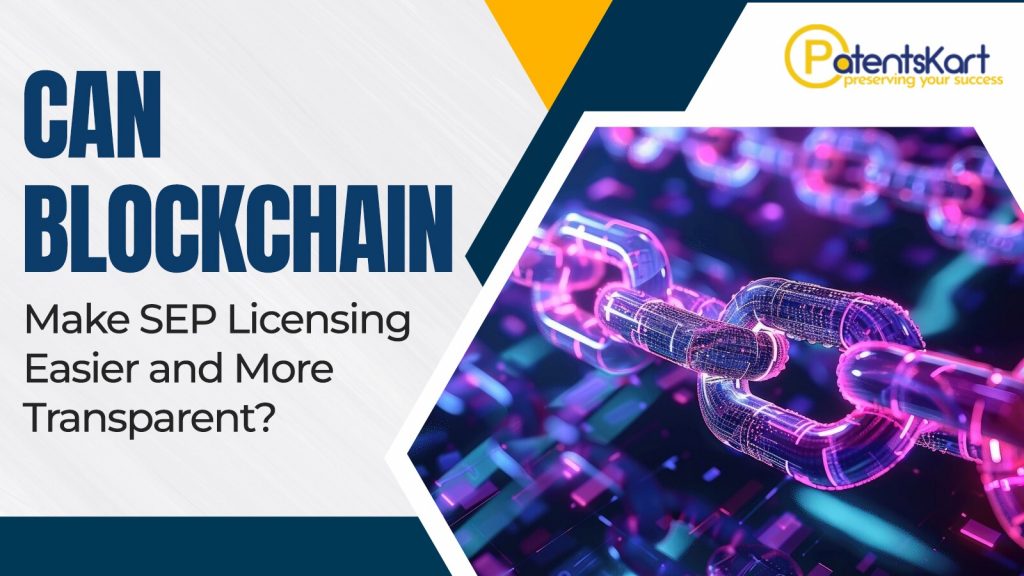Imagine a world where navigating the labyrinth of Standard Essential Patents (SEPs) doesn’t feel like a high-stakes game of negotiation, where licensing agreements are so clear and accessible that disputes are almost nonexistent. Sounds like a dream, right? But what if the technology that powers cryptocurrencies, like blockchain, could be the key to making this dream a reality in SEP licensing?
Let’s rewind to a few years ago, when a small startup, struggling to secure licenses for critical SEPs, found itself stuck in an endless loop of negotiations, delays, and growing frustration. Each time they thought they had struck a deal, new questions arose—Was the royalty rate truly fair? Were the terms non-discriminatory? Was there an easier way to track the progress of licensing payments?
This company wasn’t alone. For many in the tech industry—especially those dealing with fast-moving fields like 5G or IoT—the process of negotiating and managing SEP licenses has often felt like an uphill battle. With so many players involved, a lack of transparency, and the complexity of handling large patent portfolios, it’s no wonder that licensing disputes can escalate into full-blown litigation. But what if there were a smarter, more transparent way to handle all this?
That’s where blockchain comes in.
Instead of relying on traditional, opaque methods for tracking agreements and payments, blockchain’s decentralized nature could be the very solution the industry has been searching for. Blockchain technology allows for secure, transparent, and real-time tracking of transactions. Imagine using blockchain to record every royalty payment, every license agreement, and every patent transaction, automatically and in an immutable ledger. Both patent holders and licensees would have instant access to a trusted record of each agreement, reducing the risk of miscommunication and disputes.
Now, let’s take a closer look at how blockchain could transform SEP licensing into something far more efficient, transparent, and fair:
1. A New Era of Transparency
Let’s go back to that startup, still navigating the rocky road of licensing agreements. With blockchain, each licensing agreement could be logged in a decentralized ledger, where every involved party has access to the same data, in real-time. No more questions about who agreed to what terms or how the royalties are being calculated. Both the licensor and the licensee would see the same ledger, making the entire process transparent and reducing any potential for misunderstandings.
This shared ledger would include critical information, such as:
- The patents licensed
- The FRAND terms
- The royalty rates agreed upon
- Payment schedules
- Usage data
All this information would be publicly verifiable, allowing both parties to track the licensing process without worrying about missing terms or hidden clauses. With everything logged securely and transparently, disputes over terms would be greatly minimized.
2. Smart Contracts: Automating Royalty Payments
Now imagine this: the startup enters into a licensing agreement for a SEP. They agree to a royalty percentage based on product sales. In traditional licensing, monitoring the sale of products and collecting payments could take time, involve multiple intermediaries, and leave room for errors. However, with blockchain-based smart contracts, this entire process could be automated.
Smart contracts are self-executing agreements where the terms are directly written into code. If the patent holder and licensee agree that royalties are paid based on the number of products sold, the smart contract would automatically calculate and process the payment once the product sale is made. The best part? The blockchain would keep a permanent record of each transaction—so if there’s ever a dispute, the ledger will have the exact details of every payment.
3. Eliminating Fraud and Ensuring Accountability
Imagine that the startup was concerned about royalties being underpaid or patent ownership disputes. With blockchain’s immutable record, both the patent holders and implementers have a secure, unchangeable history of every transaction and every agreement. Once an agreement is recorded on the blockchain, it cannot be altered or tampered with.
This could drastically reduce the risk of fraudulent claims, where someone might falsely claim ownership of an SEP or attempt to underreport usage. The blockchain acts as an unforgeable record, ensuring that patent holders are paid fairly and on time, while implementers can easily verify the terms of the agreement. The transparency afforded by blockchain could go a long way in establishing trust between all parties involved.
4. Simplifying Patent Portfolio Management
Managing a portfolio of SEPs is no easy feat, especially for companies with hundreds or thousands of patents. Right now, managing and tracking licensing agreements for these patents can be a logistical nightmare. But blockchain could bring a new level of efficiency and clarity to patent portfolio management.
By recording all patents, associated licenses, and payment histories on the blockchain, companies could manage their patent portfolios more effectively. They would no longer need to sift through mountains of paperwork or outdated databases to figure out the status of a particular patent or licensing agreement. Everything would be right there, easily accessible and up-to-date.
5. Ensuring FRAND Compliance
A central challenge in SEP licensing is ensuring that patents are licensed on Fair, Reasonable, and Non-Discriminatory (FRAND) terms. Blockchain’s transparency and automated contract execution could provide an easier way to ensure FRAND compliance by making the terms and payments open and verifiable.
With a blockchain ledger, it would be much easier for both patent holders and implementers to see if the agreed terms are in line with FRAND principles. If a dispute arises about whether the terms are truly non-discriminatory, the ledger provides an auditable, verifiable record that both sides can examine.
Challenges to Overcome
While blockchain holds immense promise for the future of SEP licensing, there are a few challenges that need to be addressed:
- Adoption barriers: Widespread adoption of blockchain across the patent industry will require a cultural shift, as well as technical and legal adjustments.
- Integration with existing systems: Companies will need to integrate blockchain technology with their current patent management and licensing platforms.
- Legal framework: The legal and regulatory framework for using blockchain in SEP licensing is still in its early stages and will need to evolve.
Conclusion: A Transparent Future for SEP Licensing
Blockchain technology is already transforming industries like finance and supply chain management, and it’s poised to do the same for SEP licensing. By offering transparency, automation, and security, blockchain can help resolve some of the most common challenges in the SEP licensing process, from tracking royalties and patent ownership to ensuring compliance with FRAND terms.
For our startup, blockchain could have provided the clarity and efficiency it desperately needed, turning a complex, time-consuming process into a straightforward and transparent one. As the SEP landscape continues to evolve, it’s clear that blockchain could play a key role in driving fairer, more efficient, and dispute-free licensing for all. In the not-so-distant future, SEP licensing may no longer feel like an uphill battle, thanks to the power of blockchain.







